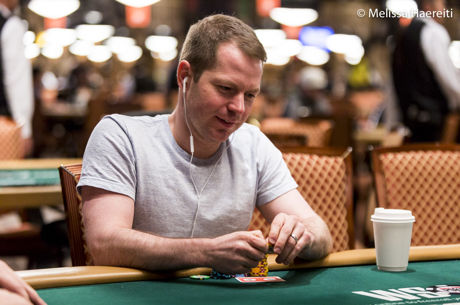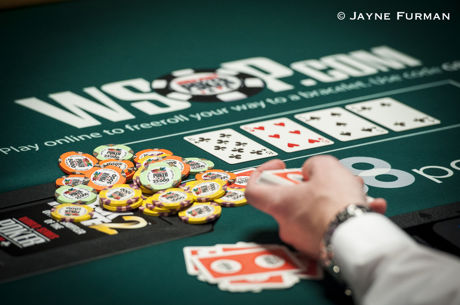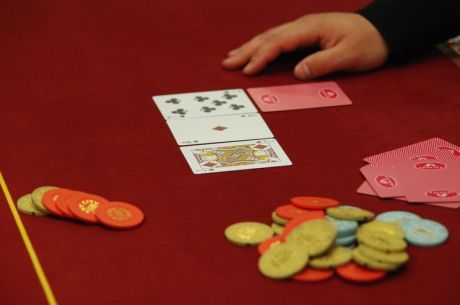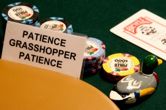Do You Have 'Jack-O-Phobia'? Playing Pocket Jacks in Live NL Hold'em
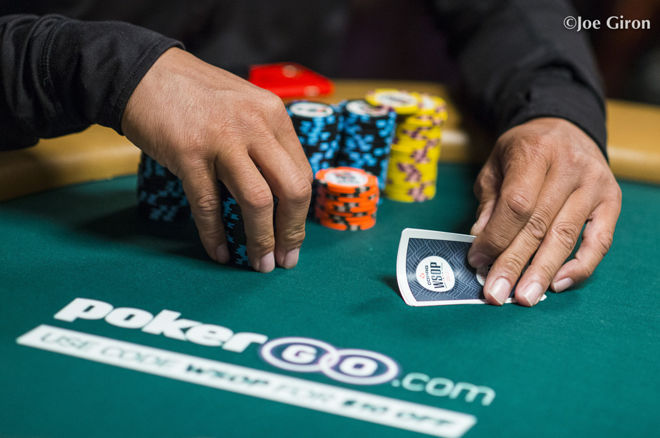
Pocket jacks hold a special place of disdain for many live $1/$2 players in Las Vegas. I often hear them say something like "I hate jacks!" yet I rarely hear the same thing about pocket queens or tens.
"Jack-O-Phobia" seems to be a real phenomenon in the lowest stakes games. From where does this dislike of pocket jacks come? Let's look a little more closely at some of the math involved with this starting hand and consider how that math should help us play the hand.
Some Preliminary Math
Jack-O-Phobia may sometimes be the consequence of misunderstanding the math. Or it may be the influence of simple cognitive biases. For instance, we tend to recall those times our jacks were crushed more strongly than when the jacks were profitable.
Reacting to another bias, some players overestimate their risk of running into a better hand �� they see monsters where they be not. But our jacks are a preflop underdog only when facing queens, kings and aces. So how likely is it that we will be facing one of these superior hands?
The chances that a particular player has pocket aces is only 0.45 percent and the chances that he has [QQ+] is only 1.35 percent! When we are dealt JxJx under the gun at a nine-handed table, there is only a 10.8 percent chance that one of the eight players behind us has us crushed. This drops to only 5.4 percent when we are in the hijack seat.
So should we be particularly afraid of being crushed? Of course not!
Perhaps a more common cause of Jack-O-Phobia is the fear of an overcard coming on the flop. What are the chances that this will happen?
There are 12 overcards among the 50 unseen cards. So the chances that the first flop card will not be an overcard is 38/50 = 76 percent. Meanwhile, the chances that no flop card is an overcard is (38/50) �� (37/49) �� (36/38) = 43 percent. In other words, we will face at least one overcard on the flop 57 percent of the time. Only 52 percent of the time does an overcard flop without us also flopping a set of jacks.
So 48 percent of the time we're sitting pretty (we hope). Yet when exactly one overcard flops (42 percent of the time), we aren't necessarily in bad shape. A much worse outcome is a two-overcard flop, which only happens 9 percent of the time. We shouldn't be paranoid about overcard flops.
Pocket Jacks: Preflop
Knowing the math, then, what should be our first thought when we have pocket jacks? "I have a premium starting hand. I should bet it for value." Whenever we are likely to have the best hand (statistically), we should want to play for higher stakes.
I normally open to 4 or 5 big blinds in a Vegas $1/$2 game, depending on the table dynamics and my position. (This is usually 3-4 BBs in a Vegas $2/$5 game.) Then I add an additional BB or so for every limper.
I generally adjust this bet size depending how many callers I expect to face. If I am playing at a call-happy table, I will bet bigger since the callers will still have wide ranges and I stand to make a bigger profit. If I am on a tight table, I might bet somewhat smaller to induce a call. But I don't adjust my bet size just because I have jack.
What should be our first thought when we have pocket jacks? "I have a premium starting hand. I should bet it for value."
I usually get callers from players with at least 20 percent calling ranges. I usually cap this range by removing AxAx and KxKx and usually QxQx, since the average Vegas $1/$2 player three-bets less than 1 percent of the time. This provides the villain with 215 calling combos (based on the Flopzilla "No-Limit" model).
With these assumptions, we are ahead of every hand in their preflop calling range (except one combo of jacks), and our equity against this range is 70 percent. This is a great place to start. In fact, this is nearly as attractive as when our aces are facing kings!
Even the tighter "Donkey Gamers" who often play these games will still call with a fairly wide range, perhaps 10 percent minus the [QQ+] overpairs. Such a villain has 99 combos against which we still have 70 percent equity. It matters very little if the villain is a tight or a loose caller.
So we always open-raise our pocket jacks when we have the opportunity. But what if someone has bet into us? The average Vegas $1/$2 player raises preflop only about 6 percent of the time, which represents a range of [88+, AK, AQ, KQs, AJs]. Our jacks have only about 53 percent all-in equity against this range. So unless he will call our three-bet with his entire open-raising range, we don't have a good opportunity to three-bet for value. We are usually better off just calling.
What if the player is a bit more aggressive, such as the 8 perecent raising range of a typical Vegas $2/$5 player? Now we can add [KQo, AJo, QJs, JTs] to his range. But our equity is still only slightly better at 55 percent, and a three-bet will usually only succeed in folding out his worst combos. Getting called by a superior range is not a winning strategy, so we should usually just call.
Another possibility is that we raise first and a villain three-bets. As already noted, the average Vegas $1/$2 player three-bets less than 1 percent of the time. This is barely [KK+] and our equity is only about 18.7 percent. Now we should usually fold to the three-bet.
Even facing a much looser three-bet range of 3 percent �� that is, [JJ+, AK, AQs] �� our equity is only 38.4 percent. If our 5-big blind bet is raised to 15 BB, we would be calling 10 BB into a 20-BB pot, which provides sufficient pot odds. We can call the three-bet in this situation if we feel we can outplay this aggressive player postflop. Perhaps we call when we have position and fold when we do not.
Overbetting Pocket Jacks
Many fearful players in these $1/$2 games will open to $20 or even $25 with pocket jacks, betting even more behind limpers. This can be a mistake if an observant foe can use his bet sizing to put such a player on a narrow range. If he overbets jacks but not [QQ+, TT], we can exploit him when the flop contains an ace, king or queen, which is 57 percent of the time.
But there is another problem with this preflop overbet. It shifts our risk/reward ratio in a bad direction. A 10 BB open is twice as risky as a 5 BB open, with the same reward. Furthermore, a villain's calling range will generally be tighter, which decreases our equity when called.
Of course, we should make a bigger raise when there are limpers. But we now have a bigger reward (the limps), and Vegas limpers typically call more widely once they have invested some money. So we can raise larger while improving our risk/reward ratio and still face wide calling ranges.
Pocket Jacks: Postflop
Our postflop decisions can be significantly more complex than they were preflop. Now we must consider the number of villains, their playing style, the flop texture and our position. I can't go into all of these factors here, but let's consider some common situations.
Suppose we raise to 5 BB and are called by one [20%] player. The flop is 10?7?3?, and he checks. He has 190 Flopzilla combos, with only nine of them ahead of us (only the sets). We have a clear value continuation bet situation, so we decide to bet about 3/4 pot.
Suppose the flop is Q?7?3?, and Mr. Villain checks. Many players will worry about the queen, but should they? Nope! Not much, anyway.
Mr. Villain has only 6 sets and 45 top-pair combos out of the 193 combos in his range, so only 26 percent of them are ahead. If he folds every inferior hand, we have 74 percent fold equity and our 3/4 pot continuation bet is easily +EV. He also has 46 other pairs which might call a moderate c-bet, which gives us a lot of equity when called. Replace the Q? with the Q? and even more inferior combos will call. A c-bet is a strong choice for either flop against most villains.
Suppose the flop is K?7?3? and the villain checks. This has exactly the same math as the previous queen-high flop. We should still usually make a moderate c-bet.
Suppose the flop is A?7?3?. Now there are 54 top-pair hands, 6 sets and 2 two-pair hands out of 189 combos. That means the villain is ahead 62/189 = 33 percent of the time. But the ace on board will scare away some of the weak-pair calling combos. So our value-bet ratio will not be as good as in the king-high and queen-high flops. Nevertheless, a 3/4 pot c-bet would be +EV because it has high fold equity.
Finally, suppose the flop is A?Q?3? and the villain checks. This flop more strongly fits the villain's calling range, with 12 two-pair-or-better combos, 45 top-pair combos and 33 middle pair combos out of a total of 179 combos in his range. He is now ahead 90/179 = 50 percent of the time.
If he folds all of his weaker hands, our fold equity would be 50 percent and a 3/4 pot bet would be +EV. The question then becomes "would I make more by checking?" Suppose we check behind and the villain checks a blank turn. Now we can discount most of his biggest hands and top-pair combos. Now a delayed turn c-bet has more fold equity than a flop c-bet had. Checking versus continuation betting on the flop might be a close call.
Let's consider the above scenarios while facing two [20%] villains instead of one. We still have a clear value bet opportunity on the 10?7?3? flop. But if we have 74 percent fold equity for each individual player on the Q?7?3? flop, our total fold equity would be (0.74) �� (0.74) = 55 percent. So a 3/4 pot c-bet is still +EV against two villains and it charges them for the opportunity to chase us with overcards or inferior one-pair hands. The same is true for the king-high flop. But notice that adding a third [20%] villain drops our total fold equity to only 40% and our c-bet decision becomes a closer one.
The A?7?3? c-bet was +EV against a single villain with a 50 percent fold equity, but two villains create a total fold equity of only 25 percent. Now a c-bet bluff is clearly unprofitable. The situation is even worse on a double-Broadway flop facing two villains. We should usually check.
Of course, there are many more scenarios we could work through. For example, what if the villain is tight, calling with only a [10%] range? What if he is bluffy or sticky? What if the flop is wet? I encourage you to work through these and other scenarios using Flopzilla. Eventually you will become comfortable with the possibilities and your Jack-O-Phobia will dissipate.
- Low-Stakes Live Games Differ from Online
- Do You Play Too Many Hands?
- Are You a Position-Dummy?
- When Can I Take a Bathroom Break?
- Is Straddling a Good or Bad Play?
- A Preflop Question: Is Limping Lame?
- Maximizing Expectation When Betting For Value
- Maximizing Expectation When Betting as a Bluff
- Five Weak Reasons to Bet (and One Weak Reason Not To)
Steve Selbrede has been playing poker for 20 years and writing about it since 2012. He is the author of five books, The Statistics of Poker, Beat the Donks, Donkey Poker Volume 1: Preflop, Donkey Poker Volume 2: Postflop, and Donkey Poker Volume 3: Hand Reading.
In this Series
- 1 Donkey Poker: Low-Stakes Live Games Differ from Online
- 2 Donkey Poker: Do You Play Too Many Hands?
- 3 Donkey Poker: Are You a Position-Dummy?
- 4 Donkey Poker: When Can I Take a Bathroom Break?
- 5 Is Straddling a Good or Bad Play?
- 6 A Preflop Question: Is Limping Lame?
- 7 Maximizing Expectation When Betting For Value
- 8 Maximizing Expectation When Betting as a Bluff
- 9 Five Weak Reasons to Bet (and One Weak Reason Not To)
- 10 Do You Have 'Jack-O-Phobia'? Playing Pocket Jacks in Live NL Hold'em
- 11 Donk Betting in Small-Stakes Live No-Limit Hold'em

